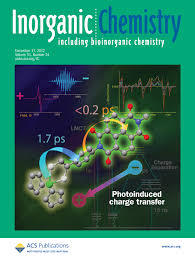Open-Framework Structures of Anhydrous Sr(CF3COO)2 and Ba(CF3COO)2
Dublin Core
Título
Open-Framework Structures of Anhydrous Sr(CF3COO)2 and Ba(CF3COO)2
Tema
ESTRONCIO
BARIO
CRISTALES
METALES
BIBLIOGRAFIA NACIONAL QUIMICA
2016
Abstract
Anhydrous Sr(CF3COO)2 and Ba(CF3COO)2 open-framework structures featuring three-dimensional connectivity of metal−oxygen polyhedra were crystallized from a mixture of water and CF3COOH. Crystallization was induced via evaporation of the solvent mixture under a dry nitrogen flow. This approach differs from that routinely employed for crystallization of metal trifluoroacetates, which achieves solvent evaporation by heating under air and yields hydrated salts. Thermogravimetric and differential thermal analysis as well as single-crystal and synchrotron powder X-ray diffraction were employed to characterize the alkaline-earth trifluoroacetate products. Neither thermal analysis nor single-crystal X-ray diffraction detected the presence of crystallization water molecules, demonstrating these trifluoroacetates can be obtained in anhydrous form. Single-crystal X-ray diffraction studies showed that Sr(CF3COO)2 and Ba(CF3COO)2 are isostructural and crystallize in the rhombohedral R3̅ space group. Both compounds belong to the class of organic−inorganic extended hybrids and exhibit an open-framework structural motif with threedimensional connectivity of the metal−oxygen polyhedra and one-dimensional channels along the c axis. The channels are decorated with the trifluoromethyl groups of the trifluoroacetate ligands, and their average (minimum) diameters are ∼3.75 (2.60) and 3.45 (2.25) Å for Sr(CF3COO)2 and Ba(CF3COO)2, respectively. This size range is comparable to the kinetic diameter of small molecules such as hydrogen (2.3 Å). Chemical substitution of barium for strontium affects not only the diameter of the channels but also the spatial arrangement of the trifluoromethyl groups within the channels and the coordination environment of the metal atoms. The different coordination requirements of the strontium and barium atoms are accommodated through the displacement of one of the two chemically distinct trifluoroacetate ligands relative to the metal center.
Autor
Dissanayake, K. Tauni
Mendoza, Laura M.
Martin, Philip D.
Rabuffetti, Federico A.
Fuente
Inorganic Chemistry v.55, 2016. -- p. 170-176
Editor
American Chemical Society
Fecha
2016
Formato
PDF
Idioma
Inglés
Tipo
Artículo
Identificador
DOI: 10.1021/acs.inorgchem.5b02081
Document Item Type Metadata
Original Format
PDF
- Fecha de agregación
- May 5, 2016
- Colección
- Bibliografía Nacional Química
- Tipo de Elemento
- Document
- Etiquetas
- Bario, Cristales, Estroncio, Metales
- Citación
- Dissanayake, K. Tauni, “Open-Framework Structures of Anhydrous Sr(CF3COO)2 and Ba(CF3COO)2,” RIQUIM - Repositorio Institucional de la Facultad de Química - UdelaR, accessed July 26, 2024, https://riquim.fq.edu.uy/items/show/3955.
- Archivos

